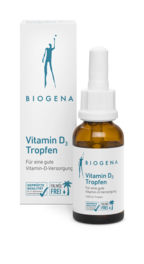Vitamin D plays a crucial role in our health. It contributes significantly to maintaining our immune system, supports the calcium and phosphate balance, strengthens the bones and teeth and contributes to muscle function. But in practice, can we even achieve sufficiently high vitamin D levels through the sun? How can you really meet your own vitamin D needs? We explain.
Forming vitamin D through sun exposure: how can I get vitamin D from the sun?
Our bodies can produce vitamin D through exposure of our skin to ultraviolet light (UV rays) from the sun. Only the sun's UVB rays activate this production. In this process, a precursor of vitamin D (provitamin D3) is converted into the active vitamin, which the body needs for various processes.
Insufficient supply: How much vitamin D does the body produce in the sun?
The amount of vitamin D produced depends on, among other things, the following factors:
- the intensity of the sun's rays (depending on the latitude, time of year and day, and weather)
- the skin type and
- the exposed skin area (depending on clothing)
People with fair skin usually need less time to produce vitamin D than people with dark skin, because melanin blocks UV radiation and thus reduces vitamin D production.
But as the Good Health Study by Biogena shows, taking in vitamin D from the sun is not enough. Over 90% of the people in the study had vitamin D levels below the optimal range, and over 80% even had a severe vitamin D deficiency. In general, vitamin D levels in Austria are in serious need of improvement.
How long do you have to be in the sun for vitamin D?
The length of time you need to spend in the sun varies depending on your skin type, geographical location, weather, time of day and season. In our part of the world, vitamin D synthesis is usually only possible between April and September, from 10 am to 3 pm, because the sun's angle of incidence does not allow enough UV radiation the rest of the year. In other latitudes, such as in countries like the UK, conditions are even worse due to the geographical location. To be able to produce vitamin D, the UV index must be above 3, which corresponds to UV-B radiation of 290–315 nm. But other countries such as Italy, Cyprus, Australia, Greece and others are also severely affected by vitamin D deficiencies. A large proportion of the population there is not optimally supplied either, despite plenty of sunshine.
One thing is certain: despite plenty of sunshine and optimal conditions, our bodies are unable to ensure an adequate supply of vitamin D through UV rays.
Tips for daily sunbathing:
- Seek out direct sunlight daily between April and September in sunny weather
- It is important to expose naked skin (at least 40% of the skin uncovered)
- Do not use sunscreen during the first 10-40 minutes of sunbathing, depending on skin type (light skin types must apply sunscreen immediately, but this has a direct effect on the body's own vitamin D synthesis)
- Only be in the sun in the morning or afternoon and spend the middle of the day in the shade to protect your skin
- Take vitamin D as a dietary supplement (year-round)
When does the risk of sunburn start?
Alongside the sun's positive properties, there is also the risk that sunburn can cause skin cancer. The risk of sunburn begins as soon as the skin is exposed to the sun unprotected for too long. Light-skinned people can develop sunburn after just 10 to 20 minutes, while darker-skinned people can stay unprotected in the sun for up to 40 minutes or more before redness occurs. It is therefore advisable to avoid direct midday sun and instead to spend time outside in the morning or afternoon.
Can the skin produce vitamin D despite sunscreen?
Yes, but much less than without sunscreen. Sunscreen with an SPF protects the skin from UV radiation and thus theoretically blocks vitamin D photosynthesis. However, users usually apply the sunscreen much more thinly, which means that the protection is not 100% effective and some vitamin D can still be synthesised.
To produce vitamin D through the skin, 40% of the body surface should be uncovered and not covered with cream. The skin should be exposed to the sun for 10-15 minutes when the sun is at its ideal position. However, it is not possible to get an adequate supply of vitamin D from the sun alone. Targeted supplementation is necessary for this.
Which part of the body absorbs vitamin D best?
Uncovered and sun-exposed skin areas are crucial for vitamin D production. The face, arms and hands are particularly effective because these body parts are often uncovered and offer a large area. However, care should always be taken to ensure adequate protection against sunburn.
Can you absorb vitamin D in the shade?
Yes, the body can produce small amounts of vitamin D in the shade. UVB radiation is reduced here, which affects the efficiency of vitamin D synthesis.
Insufficient vitamin D production worldwide
UVB radiation is generally too weak worldwide to ensure sufficient vitamin D formation from the sun. Studies show that a large proportion of people have low vitamin D levels and suffer from a deficiency.
The only way to effectively take in enough vitamin D is to take targeted dietary supplements. Supplementing is the only way to prevent vitamin D deficiency.
Sources:
Bischoff-Ferrari HA, et al. A pooled analysis of vitamin D dose requirements for fracture prevention. N Engl J Med. 2012;367(1):40-9. https://pubmed.ncbi.nlm.nih.gov/22762317/
Bischoff-Ferrari HA, et al. Fall prevention with supplemental and active forms of vitamin D: a meta-analysis of randomised controlled trials. BMJ. 2009;339:b3692. https://pubmed.ncbi.nlm.nih.gov/19797342/
EFSA Panel on Dietetic Products, Nutrition and Allergies (NDA). 2012. Scientific Opinion on the Tolerable Upper Intake Level of vitamin D. EFSA J. 10(7):2813.
Godar DE, Pope SJ, Grant WB, Holick MF. Solar UV Doses of Young Americans and Vitamin D3 Production. Environmental Health Perspectives. 2012 Jan;120(1):139-143. https://pubmed.ncbi.nlm.nih.gov/21852226/
Heaney, R. P. 2005. The Vitamin D requirement in health and disease. J Steroid Biochem Mol Biol. 97(1–2):13–9.
Lucas RM, et al. Human health in relation to exposure to solar ultraviolet radiation under changing stratospheric ozone and climate. Photochem., Photobiol. Sci. 2019;18,641. https://pubmed.ncbi.nlm.nih.gov/30810559/
Norman, A. W. 2008. From vitamin D to hormone D: fundamentals of the vitamin D endocrine system essential for good health. Am J Clin Nutr. 88(2):491S–9S. https://pubmed.ncbi.nlm.nih.gov/18689389/
Palacios, C., Gonzalez, L. 2014. Is vitamin D deficiency a major global public health problem? J Steroid Biochem Mol Biol. 144(Pt A):138–45. https://pmc.ncbi.nlm.nih.gov/articles/PMC4018438/
Schoenmakers, I. et al. 2016. Prediction of winter vitamin D status and requirements in the UK population based on 25(OH) vitamin D half-life and dietary intake data. J Steroid Biochem Mol Biol. 164:218–22. https://pubmed.ncbi.nlm.nih.gov/26970588/
Liu D, et al. Vitamin D and Multiple Health Outcomes: An Umbrella Review of Observational Studies, Randomized Controlled Trials, and Mendelian Randomization Studies. Adv Nutr. 2022 Aug 1;13(4):1044-1062. https://pmc.ncbi.nlm.nih.gov/articles/PMC9340982/
Wäger et al. 2022. BIOGENA Good Health Study: Vitamin D. unveröffentl.
Sinnißbichler T., Viebahn I. 2011. Vitamin D gesucht - Defizite gefunden. 25-(OH)-Vitamin D Status, Supplementierung und Krankheitstage. unveröffentl.
Webb AR, et al. Sunlight and Skin Type as Drivers of Vitamin D Deficiency at UK Latitudes. Nutrients. 2018;10(4):457. https://pmc.ncbi.nlm.nih.gov/articles/PMC5946242/
Xyda SE, et al. Could the Majority of the Greek and Cypriot Population Be Vitamin D Deficient? Nutrients. 2022 Sep 13;14(18):3778. https://pmc.ncbi.nlm.nih.gov/articles/PMC9502779/









